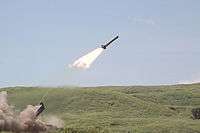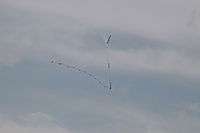Mine-clearing line charge
A mine-clearing line charge (abbreviated MICLIC and pronounced /mɪk.lɪk/ or "mick-lick") is used to create a breach in minefields under combat conditions. While there are many types, the basic design is for many explosive charges connected on a line to be projected onto the minefield. The charges explode, detonating any buried mines, thus clearing a path for infantry to cross. The system may either be human-portable or vehicle-mounted. The systems do not guarantee clearance of all types of mines.[1]
History



The British and Commonwealth developed their systems during the Second World War. The Canadians developed "Snake", an oversized application of the Bangalore torpedo in 1941 to 1942.[2] A more flexible development was "Conger", developed in 1944, a tube that could be fired across the minefield and then filled with explosive before detonation.[3]
Conger was a 2-inch woven hose launched by a five-inch rocket. The tube and rocket were mounted in a Universal Carrier which had been stripped out to reduce it down to an armoured tracked trailer that could be towed by a tank, often a Churchill AVRE. The rocket was fired, trailing the hose across the area to be cleared. Compressed air was then used to pump the liquid explosive - just over a ton of "822C" nitroglycerin - into the hose before it was detonated. Conger was used in Normandy where there were instances of premature detonation.[4]
In the postwar period the British introduced Giant Viper.
In 1991, during the First Gulf War (aka the Persian Gulf War) MICLICs, such as the Giant Viper, consisted of rocket launched lines containing roughly 800 kilograms of explosives, stretching some 100 meters long. These MICLICs were used by Coalition forces to penetrate Saddam Hussein's extensive minefield along the Saudi-Kuwait border.[5]
Current use
Systems in current use include the British Python, which can clear a 7.3 m wide by 180–200 m long path, and the American M58 Mine Clearing Line Charge, which can clear an 8 m wide by 100 m long path.[6] Both are large, heavy systems that are deployed in a vehicle-towed trailer. The US Army also uses the Antipersonnel Obstacle Breaching System, which clears a path 0.6 to 1.0 meters by 45 meters, and is light enough to be carried by two soldiers.
Some modern mines, such as the Italian SB-33 mine, have a fuze mechanism that detonates the mine if subject to gradual, steady pressure, but locks the fuze if subject to a sudden shock. This can defeat the use of mine-clearing line charges to clear such mines.
Examples
- Charge Line Mine Clearing (Vehicle)-Indian
- UR-77 (УР-77) Meteorit Mineclearing System (rocket launched explosive hose),[7] replacement of the UR-67 system based on the BTR-50PK chassis.[8]
References
- Notes
- уБРЕТ-5(ETEL) пЗМБЧМЕОЙЕ ТБЪДЕМБ -ЙОЦЕОЕТОБС ФЕИОЙЛБ. index-texnica.html Archived 2001-05-08 at Archive.today
- Swettenham 1968, p. 217.
- https://fas.org/man/dod-101/sys/land/docs/981100-schneck.htm
- Fletcher, The Universal Tank 1993 HMSO 0 11 290534 X p94
- Alberto Bin, Richard Hill and Archer Jones. Desert Storm: A Forgotten War. Connecticut: Praeger, 1998, 157. and Roy Boulting. Modern Warfare: The Persian Gulf War. Total Content Digital. 2003. DVD.
- M58 MICLIC. FAS.org. Retrieved 16 June 2013.
- "Мiнiстэрства абароны РБ - Устаноўка размініравання Ур-77". Archived from the original on 2012-02-11. Retrieved 2008-04-28.
- "Archived copy". Archived from the original on 2007-09-06. Retrieved 2008-04-28.CS1 maint: archived copy as title (link) Yuri Veremeyev, Zmei Gorinich and URka, Popular Muchanics, May 2007
- Bibliography
- Swettenham, John (1968). McNaughton. Volume 2 (1939-1943). Ryerson Press. ISBN 978-0770002381.CS1 maint: ref=harv (link)
External links
![]()